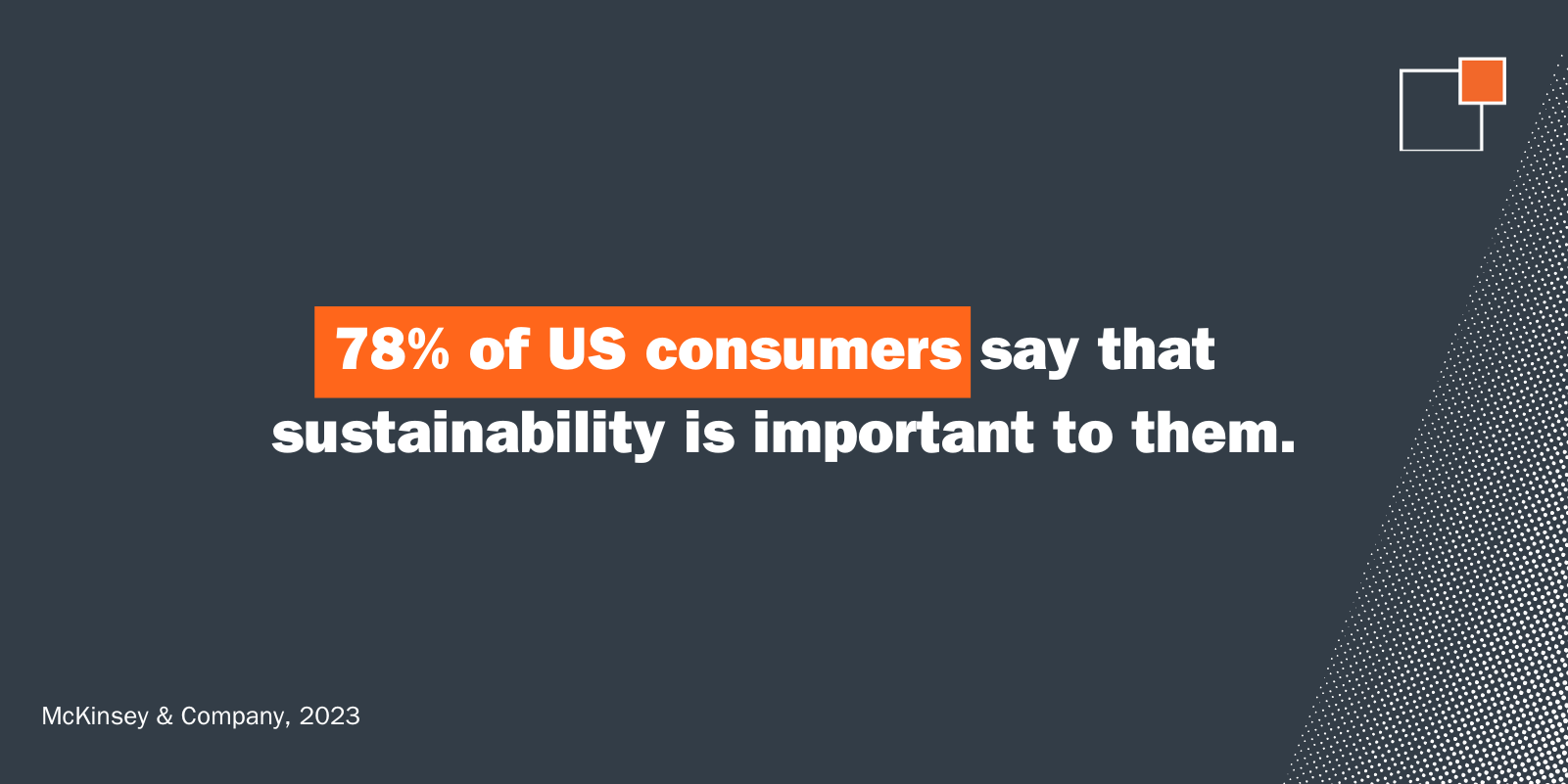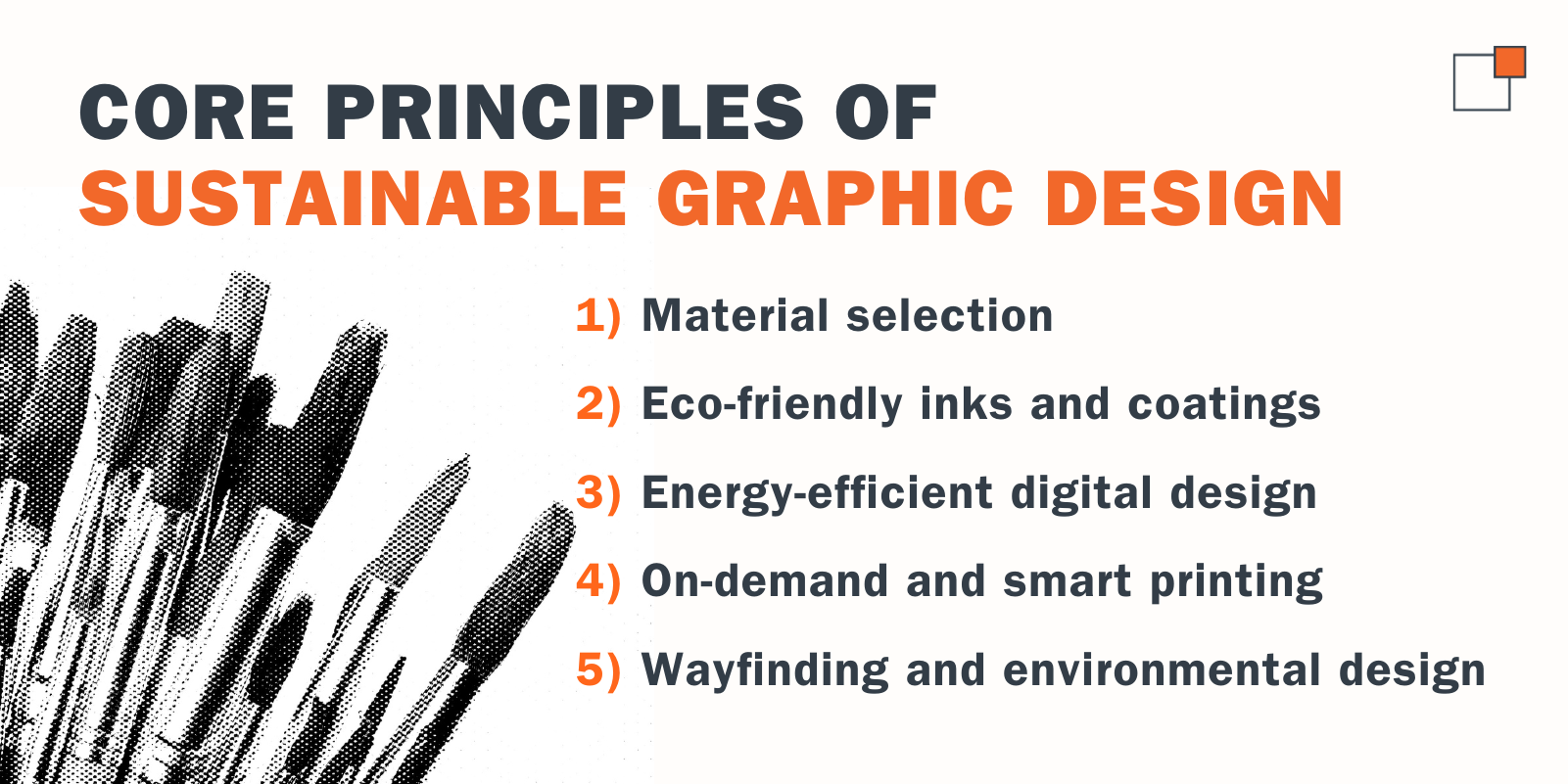Sustainable Graphic Design
Creating Impact Without Waste
Every visual experience we encounter—whether on a website, product packaging, digital interface or printed material—has been shaped by design. From colors and typography to materials and layout, each element influences how we engage with brands and process information. Good design helps guide decision-making, strengthens brand identity and enhances user experience.
For businesses, recognizing the impact of design is essential. Graphic design has the power to tell a brand’s story, evoke emotions and drive consumer behavior. This is especially true in environmental graphic design, where visual communication extends beyond traditional branding to create immersive experiences. Whether through wayfinding systems, sustainable packaging or dynamic digital displays, design plays a critical role in how people perceive and interact with a brand.
As the industry evolves, so does the responsibility to ensure these design choices are sustainable. Traditional graphic design practices often rely on materials and production methods that generate waste, pollution and excessive energy consumption. Sustainable graphic design seeks to address these issues by integrating eco-friendly materials, energy-efficient production methods and digital-first solutions. From using responsibly sourced paper and non-toxic inks to optimizing digital assets for lower energy consumption, sustainability in design ensures visual communication remains impactful without harming the planet.
Regardless of industry, every brand has an environmental footprint. Whether through printed materials, signage or digital assets, the design choices businesses make can either add to the problem—or help build a more sustainable future.

The environmental toll of traditional design:
By transitioning to sustainable design practices, graphic designers can significantly reduce these negative effects. Eco-friendly solutions not only help the planet but also align with growing consumer demand for ethical and sustainable branding.
Over the years, consumers have been increasingly prioritizing sustainability in their purchasing decisions. Companies that embrace sustainability as part of their identity don’t just appeal to environmentally aware audiences; they elevate their reputation and become industry leaders.
Beyond consumer demand, sustainable design offers tangible business benefits. Reducing material waste, optimizing production processes and prioritizing efficiency can lead to significant cost savings. All in all, it's a win-win situation!
By considering the environmental impact of materials, production methods and digital assets, designers can create meaningful work that aligns with sustainability goals without sacrificing quality. Some areas designers should think about include:
The materials used in design projects play a significant role in their environmental footprint. Opting for recycled, FSC-certified or biodegradable materials helps reduce deforestation and landfill waste while supporting responsible sourcing. When print is necessary, designers can explore alternative substrates like hemp-based paper or stone paper, which require fewer resources to produce.
Lighting choices are another factor in sustainability. LED lighting consumes up to 80% less energy than traditional bulbs, making it a smart choice for illuminated signage. Motion-sensor or solar-powered displays further reduce energy consumption while enhancing the customer experience.
To truly understand the environmental impact of design choices, businesses and designers should use Life Cycle Assessment (LCA)—a method for evaluating the total environmental footprint of a product, from raw material extraction to disposal.
LCA helps answer critical sustainability questions:
Key Stages of LCA in Graphic Design:
By integrating sustainability into branding, digital experiences and environmental design, companies can create compelling visuals without compromising the planet. The best design is not only beautiful and functional—it’s responsible.
Looking to bring sustainability into your business? Our designers are ready to help you make a lasting impact with eco-friendly solutions tailored to your brand. Let’s chat and create something responsible, beautiful and impactful together!

For businesses, recognizing the impact of design is essential. Graphic design has the power to tell a brand’s story, evoke emotions and drive consumer behavior. This is especially true in environmental graphic design, where visual communication extends beyond traditional branding to create immersive experiences. Whether through wayfinding systems, sustainable packaging or dynamic digital displays, design plays a critical role in how people perceive and interact with a brand.
As the industry evolves, so does the responsibility to ensure these design choices are sustainable. Traditional graphic design practices often rely on materials and production methods that generate waste, pollution and excessive energy consumption. Sustainable graphic design seeks to address these issues by integrating eco-friendly materials, energy-efficient production methods and digital-first solutions. From using responsibly sourced paper and non-toxic inks to optimizing digital assets for lower energy consumption, sustainability in design ensures visual communication remains impactful without harming the planet.
Why sustainability matters in graphic design
Regardless of industry, every brand has an environmental footprint. Whether through printed materials, signage or digital assets, the design choices businesses make can either add to the problem—or help build a more sustainable future.

The environmental toll of traditional design:
- Paper waste and deforestation: The graphic design industry burns through massive amounts of paper, leading to deforestation and overflowing landfills.
- Harmful inks and coatings: Conventional printing inks often contain volatile organic compounds (VOCs), which pollute the air and water.
- Energy-intensive production: Large digital files and high-resolution assets require significant energy for storage, hosting and processing.
By transitioning to sustainable design practices, graphic designers can significantly reduce these negative effects. Eco-friendly solutions not only help the planet but also align with growing consumer demand for ethical and sustainable branding.
Corporate responsibility and consumer expectations
Over the years, consumers have been increasingly prioritizing sustainability in their purchasing decisions. Companies that embrace sustainability as part of their identity don’t just appeal to environmentally aware audiences; they elevate their reputation and become industry leaders.
Beyond consumer demand, sustainable design offers tangible business benefits. Reducing material waste, optimizing production processes and prioritizing efficiency can lead to significant cost savings. All in all, it's a win-win situation!
Core principles of sustainable graphic design
By considering the environmental impact of materials, production methods and digital assets, designers can create meaningful work that aligns with sustainability goals without sacrificing quality. Some areas designers should think about include:
Material selection
The materials used in design projects play a significant role in their environmental footprint. Opting for recycled, FSC-certified or biodegradable materials helps reduce deforestation and landfill waste while supporting responsible sourcing. When print is necessary, designers can explore alternative substrates like hemp-based paper or stone paper, which require fewer resources to produce. Eco-friendly inks and coatings
Traditional printing inks often contain chemicals that contribute to air and water pollution. Switching to soy-based, water-based or low-VOC (volatile organic compound) inks minimizes these harmful emissions while maintaining vibrant, high-quality prints. Additionally, using aqueous or biodegradable coatings instead of plastic-based laminates ensures that printed materials can be recycled or composted without leaving behind microplastics.Energy-efficient digital design
Digital design may seem eco-friendly by nature, but large file sizes, high-resolution graphics and data storage all contribute to energy consumption. Optimizing digital assets by compressing files, using efficient coding practices and minimizing redundant storage helps lower the carbon footprint of websites, apps and marketing materials. Choosing web hosting services powered by renewable energy is another way to make a digital presence more sustainable.On-demand and smart printing
Overproduction is a major issue in print design, leading to excess inventory that often ends up discarded. On-demand printing ensures that only the necessary quantity is produced, cutting down on material waste and costs. Efficient layout design, such as maximizing the number of pieces per sheet and eliminating unnecessary print areas, further reduces the amount of material used.Wayfinding and environmental design
For businesses with physical locations, sustainability extends to wayfinding systems, environmental graphics and signage. Instead of traditional PVC-based signs, designers can choose bamboo, recycled aluminum or upcycled materials that offer durability with a lower environmental impact. Digital displays can replace static signage, reducing waste over time while allowing for real-time updates.Lighting choices are another factor in sustainability. LED lighting consumes up to 80% less energy than traditional bulbs, making it a smart choice for illuminated signage. Motion-sensor or solar-powered displays further reduce energy consumption while enhancing the customer experience.
Life Cycle Assessment (LCA)
To truly understand the environmental impact of design choices, businesses and designers should use Life Cycle Assessment (LCA)—a method for evaluating the total environmental footprint of a product, from raw material extraction to disposal.
LCA helps answer critical sustainability questions:
- How much energy and water are used in the production of materials?
- What carbon emissions result from transportation and manufacturing?
- How long will the product last before it needs replacement?
- Can it be recycled, composted or repurposed after use?

Key Stages of LCA in Graphic Design:
- Raw material extraction: Identifying the environmental impact of paper, inks, plastics and substrates used in design projects.
- Production and manufacturing: Assessing emissions from printing processes, coatings and digital energy consumption.
- Distribution and transportation: Measuring carbon emissions from shipping and logistics of printed materials.
- Usage phase: Understanding how a design functions over time (e.g., is it durable or does it require frequent replacement?).
- End-of-life disposal: Considering whether materials can be recycled, composted or safely disposed of.
By integrating sustainability into branding, digital experiences and environmental design, companies can create compelling visuals without compromising the planet. The best design is not only beautiful and functional—it’s responsible.
Looking to bring sustainability into your business? Our designers are ready to help you make a lasting impact with eco-friendly solutions tailored to your brand. Let’s chat and create something responsible, beautiful and impactful together!

About the Author
Gabriella Caldwell is a Digital Marketing Strategist at thunder::tech. Outside of the office she can be found in a ceramics studio sculpting away, or visiting local art galleries.
